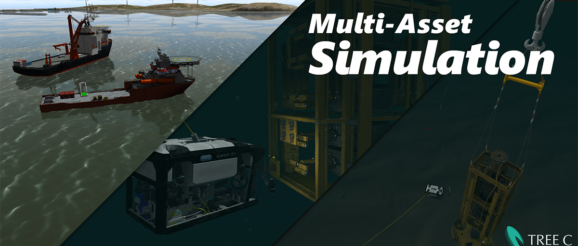Multiple Assets In One Offshore Simulator: An Innovation In Simulation

There’s a new approach to simulating offshore operations – and it’s a game changer. It’s now possible to simulate multiple assets in one simulator. We don’t just mean simulating different equipment inside the same simulator hardware setup. We’re talking about simulating multiple vessels, machinery, and the real-world environment in which they operate in the same interactive environment. Here’s how it can be used to add value to your offshore operations.
The advantage of simulating multiple assets at once
Single-purpose simulators are great – up to a point – but what’s even better is a flexible framework where multiple interactive 3D assets can be combined. Digital counterparts of real equipment are available in a library and can be combined and configured to simulate any specific operation.
By opening up this level of configurability, your simulator can support different offshore operations – including multi-asset cooperation. Take dredging, for example. Imagine it needs more power to pump water and mud to shore. This is possible with a booster station. But what difference will it make?
Simulating dredging with a booster and without, and perhaps with one vessel acting as the booster station to another, is all possible in a multi-asset environment. This means you can test out the impact before real-world operations begin. You can also simulate different human roles within the operation – including communication between vessels. This adds a lot of value for training purposes.
Another scenario is simulating the act of a tugboat pushing a barge to the side of a vessel to keep it in position. With multi-asset simulation, the tug boat operator can also be involved in the same training session. This is just one example. With a whole library of assets, you can flexibly combine them to create different real-world scenarios – including actual environments – such as a harbor.
Limitlessly adapt to different real-world conditions
In contrast to a single-purpose simulation, being able to simulate and configure multi-asset scenarios provides almost endless possibilities for offshore companies. It’s a chance to create training programs that reflect actual conditions and equipment. This is easier than you think.
A simulator from Tree C enables companies to devise their own scenarios with minimal technical simulator development knowledge or input from us. In fact, we train our clients to do this themselves. All the assets we use are also available to them. Take a harbor environment. It’s possible to stack and arrange virtual ship containers to reflect their real-world positions. The ability to arrange assets in this way is important because the environment in which this kind of work takes place, really defines how to go about it.
In dredging, for instance, clearing a canal is hugely different from preparing a seabed for installing a tunnel. With a multipurpose simulator, it’s possible to do both. The benefit of this over a single-purpose simulator with limited predefined scenarios is clear: you can easily create a simulator scenario to suit every project.
Whether you’re decommissioning oil platforms, or building a new wind farm, simulators can support operations – especially those which involve heavy lifting – by providing a safe environment to both test out potential maneuvers, train operators, and validate new equipment. You can also test out multiple variations of the same operation. This also gives experienced operators a chance to share their knowledge during a practice session on the simulator.
Of course, the real beauty of having a multi-asset simulator is that it can evolve with your operations. It can adapt to whatever’s on the horizon for your offshore operations, now and in years to come. It’s a flexible and future-proof framework.
Discover what multi-asset simulation can do for your operations. Speak to a specialist at Tree C
The post Multiple Assets In One Offshore Simulator: An Innovation In Simulation appeared first on Tree-C.
